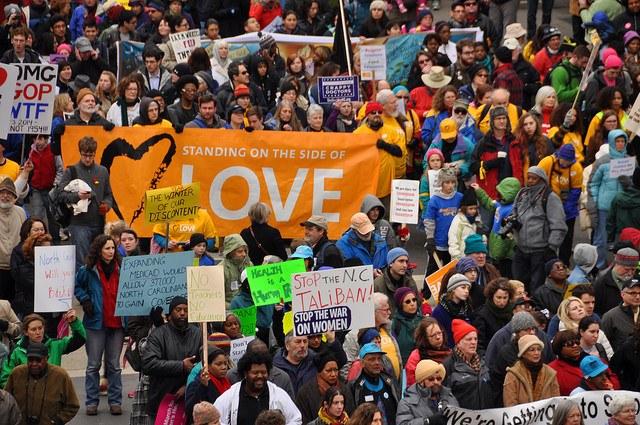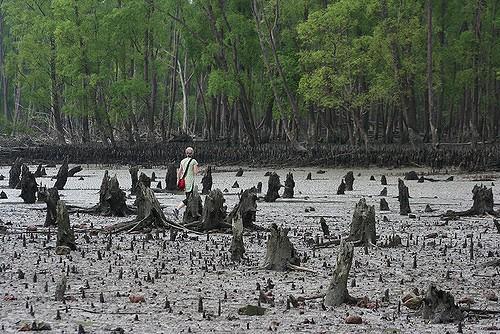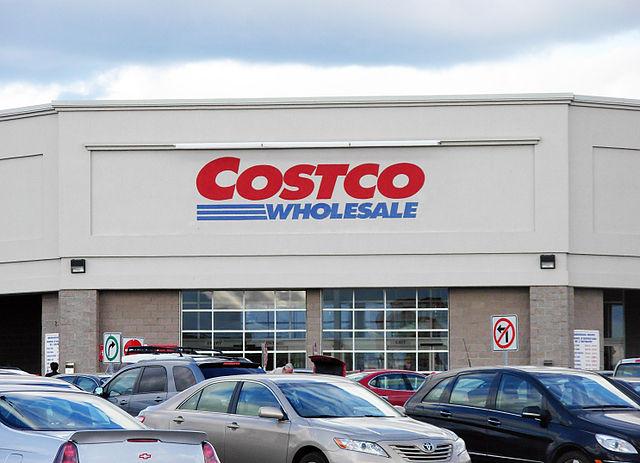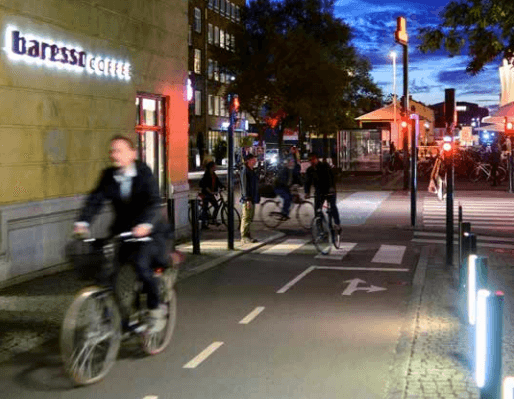Companies Push Back Against Hate Laws


Sure, North Carolina's anti-LGBT "bathroom law" is terrible. So is the new Mississippi law that allows businesses to refuse service to gay people. But the swift negative reaction to these laws says a lot about where the country is going.
On March 23, North Carolina's governor and state legislature passed HB-2. The sweeping law reversed a city ordinance in Charlotte that extended some rights to people who are gay or transgender. On April 5, Mississippi passed HB-1523, which promises that the state will not punish people who refuse to provide services to people because of a religious opposition to same-sex marriage, extramarital sex, or gender transitions.
The media immediately gave North Carolina and Mississippi a pounding. So did celebrity activists like Bruce Springsteen, who cancelled his April 10 concert in Greensboro, North Carolina, as a protest. "Some things are more important than a rock show and this fight against prejudice and bigotry — which is happening as I write — is one of them," Springsteen wrote.
Take a step back, and you'll see conservative politicians who are being forced to choose between anti-gay voters and powerful industries that have adopted zero-tolerance policies toward discrimination. In the long run, this won't be much of a contest.
On March 28, Georgia Gov. Nathan Deal vetoed a bill similar to Mississippi's after Coca-Cola, Disney, Salesforce, Home Depot, Unilever and many other companies issued statements opposing the bill. Immediately after the North Carolina law passed, Paypal cancelled plans to add 400 jobs to its operation in the state; other companies followed. And while South Carolina's legislature is now considering its own "bathroom bill," the state's governor, Nikki Haley, has already said she thinks it's unnecessary. Haley is on the 2016 shortlist for Republican vice-presidential candidates.
This is about right and wrong, but it's also about dollars and cents. Artists like Harry Belafonte, Sammy Davis, Jr. and Paul Newman were important allies to the civil rights movement in the 1960s, according to a new book by historian Emilie Raymond. The difference is that, these days, celebrity activists like Springsteen, Elton John and Emma Watson have a lot more clout than Sidney Poitier did.
The arts and entertainment industries now account for 4 percent of America's GDP, and that is just the tip of the spear. One recent study found that "creative industries" contributed $294 billion to California's economy in 2013, or more than 8 percent of the state's economic activity.
While definitions vary, a list of creative industries usually includes advertising, architecture, crafts, design, film, television, radio, software and computer services, publishing, museums and galleries, music, toys and games, and the performing arts. Some people also include the restaurant industry, scientific research and development, and some branches of engineering.
These industries produce a lot of wealth. They also produce copyrights and patents that create even more wealth for other industries such as law, financial services and construction. And they depend on young professionals who don't understand why LGBT issues are even issues. Seventy percent of millennials (aged 34 and younger) supported same-sex marriage in 2015, according to the Pew Research Center, compared with only 45 percent of baby boomers (aged 51 to 70). And nearly 7 in 10 Americans with a college degree supported gay marriage in 2014, according to an analysis of the General Social Survey, compared with fewer than 4 in 10 high school drop-outs
This isn't to say that hate laws aren't a problem. But the trends are clear. Demographics is destiny, and the anti-gay movement is destined to go away.
Image credit: Flickr/James Millamor
Bangladesh's Growing Coal Deals Prompt Criticism, Protests over Environment


When most people think of Bangladesh's most prolific industries, it's garments -- not coal -- that comes to mind. The tiny country of Bangladesh, nestled in the armpit of India's easternmost provinces, is second only to China in garment exports. Its booming electrified clothing industry is at the mercy of the country's electricity grid, yet most of the current is supplied by gas exploration, not coal.That's because, according to SourceWatch, a meager 2.5 percent of Bangladesh's electricity is supplied by coal, from one single coal mine.
Until now, that is. Earlier this year, the government of Bangladesh embarked on two lucrative deals that would significantly increase demand on its coal reserves. The first was with India, which entered into an agreement with Bangladesh in February to build a 1,320-megawatt power plant in southern Bangladesh. The plan will be run on coal and operated jointly through the Bangladesh-India Friendship Power Co. Ltd. (BIFPCL). It is one of several India-Bangladesh projects planned for the area.
The second is a joint-operated power plant with China, agreed upon last month. Its two units will generate 620 MW each and will be run through the Bangladesh-China Power Co. Ltd. (BCPCL). Two Chinese firms, SEPCOIII Electric Power Construction Corp. and HTG Development Group Corp., are financing the operation.
But even though Bangladesh desperately needs more electricity (the country's power grid is one of the smallest in the world, with almost half of its population without access to power), not everyone is confident that the country's plans to increase its coal power generation is a good thing.
That is, in part, because at least one of the proposed coal plants will sit inside the Sundarbans, a UNESCO World Heritage Site and the largest mangrove forest on earth. Local farmers say the plants will pollute and destroy the area's delicate ecology, home to Bengal tigers and other endangered species. According to local farmers, the plants would also force thousands of residents to relocate. Some have accused the developer of the Bangladesh-China plant of shady land grabs that residents say are preventing them from earning a living.
Last week, protests against the two projects reached a fever pitch. Police opened fire on a crowd of 15,000 on Monday, killing four and injuring at least 12 villagers who had turned out to protest the new Bangladesh-China plants. Thousands of people were also charged with vandalism and assault, although villagers say the protest was peaceful. Human rights and environmental organizations are calling for an investigation.
Critics point out that this is also not the first time the Bangladeshi police have opened fire on protesters. In 2013, hundreds of protesters were killed or injured at the site of the collapsed Rana Plaza garment factory. The family members and survivors of the factory collapse were rallying to demand compensation for back wages. In 2006, police opened fire on villagers protesting another coal plant.
Last year, after several attacks against police personnel, the government of Bangladesh announced that police would have the power to fire back against suspected attackers if the police felt they needed to protect themselves. Interestingly, the rules of police conduct don't provide authorization for firing into a crowd. But the recent deaths and the sweeping "arrests" of villagers who may have been present at the gatherings paint a worrisome picture for both human rights and the Sundarbans' environmental legacy
The expansion of Bangladesh's electricity grid comes at an opportune time for the country. But the temptation to dig deep into its coal reserves highlights a real dilemma that many countries are facing right now: How does one balance the demands of 21st-century advancement, the impacts of climate change and the demand for ecologically-smart decisions that protect citizens? With China and India both eying the Bangladeshi coastline for investment, it's not hard to see the quick answer. But will it be an investment that will protect Bangladesh's fertile delta from climate change in coming years?
Images: Flickr/eGuide Travel; Flickr/Frances Voon
Costco Moves Into Organic Investments to Ensure Supply


Costco is a retailer that believes paying its workers well and providing real benefits are profitable business practices. Now, the company is looking at working directly with farmers to ensure an ongoing supply of something that's in higher and higher demand from consumers – organics.
The idea is this: If Costco can invest in producers to help them transition to organic, then the retailer can rely on them through “first buyer” agreements and get more organic food for its stores. From the Seattle Times:
"Costco is loaning money to help San Diego-based Andrew and Williamson Fresh Produce buy equipment and 1,200 acres of land in the Mexican state of Baja California. But Costco is looking at expanding the initiative. The idea is to ensure a greater supply of organic foods at a time when demand is soaring but supply has not kept up.”
Costco is not alone in this. Chipotle (before the recent scandals) looked into running its own farms to ensure a ready supply of organic meat, a problem most recently highlighted when it had to stop selling pork for weeks at several stores late last year. In New York City, farmers markers are literally at capacity, unable to expand or bring in more fresh produce to meet unceasing demand.
Nationally, organics are booming. Sales of organic food jumped from $11.13 billion in 2004 to $35.95 billion in 2014, according to the Organic Trade Association. That is astounding growth, about 10 percent a year, far greater than the 2 percent for the food industry overall. And the fact is: If there was more organic produce, that number could be much, much higher.
Part of this is due to larger, structural issues – namely the vast control of agriculture by big companies, such as Tyson (chicken) or Monsanto (seeds). We've built a system that relies on monoculture, mass-produced, pesticide-heavy food, and transitioning that system into sustainable, organic agriculture is tough. Moreover, the vast majority of government incentives do not go to organic producers, but to the aforementioned mass farms.
Costco's move shows that companies have to play a more active role in their supply chains if they are to not only ensure ample supplies of ethical inputs, but also to meet consumer demand. If Costco can, through its investment, provide a larger supply of organics than its competitors, then you can bet this will show up on its bottom line.
Another thing Costco, Whole Foods and other retailers could do: Push for government policies that promote organics, through subsidy equality and an accounting system that incorporates organics' lower ecological footprints into pricing. Then the planet, consumers, and forward-thinking companies like Costco and its suppliers would all be better off.
Image credit: Stu pendousmat via Wikimedia
This System Recovers Heat Energy from Sewage


Our planet is facing a potentially devastating climate emergency, partly due to the fact that the infrastructure we have set up to deliver food, energy and water is incredibly wasteful at every step of the process. A full 40 percent of the food produced in this country is wasted before it can be consumed. That waste occurs at the farm, delivery, retail and consumer levels. The same thing is true for energy. Inefficient power plants deliver electricity to a transmission and distribution system that wastes 6 percent of that energy before it reaches our homes, where a whole lot more is wasted. All totaled, we waste over 60 percent of the energy we produce.
The good news in this, if there is any, lies in the numerous opportunities that are emerging to do something about this. Whether this is a matter of closing the barn door after the horse has escaped is a philosophical one, but the fact is: As you read this, horses are still escaping.
A vast amount of this wasted energy is given off as heat -- heat that we could be using instead of paying more for additional energy that is turned into heat. Recovering some of that heat as it is literally washed down the drain is the idea behind a system from Canadian firm International WasteWater.
The idea is somewhat similar to that of a heat recovery ventilator (HRV) that pulls heat out of air that is being exhausted from a building, and sends it back inside. The difference between an HRV and the two systems produced by International Wastewater, the Sharc and the Piranha, is that they pull heat from the waste water leaving a building through the sewer line rather than exhausted air.
According to the DOE, some 400 billion kilowatt-hours of energy are literally washed down the drain in the U.S. every year. To get an idea of the magnitude of this waste problem: The city of Denver found itself in trouble because the temperature of its wastewater discharge is too high -- potentially threatening the aquatic environment, said Lynn Muller, founder of International Wastewater. The city is now installing a number of Muller's systems to remove some of that heat and put it to good use.
While an HRV uses a heat exchanger to grab heat, the International Wastewater System products use heat pumps, which are far more effective in collecting heat. The heat pumps then use that heat to produce more hot water.
It’s a little more complicated than that, but not much. The system also requires pumps, storage tanks, filters and something called a macerator to make sure that the sewage keeps flowing (video). Because of the cost of the equipment, the systems make sense economically in larger, multi-family residential buildings, where there is lots of heat to be captured and lots of hot water required. Once the heat has been extracted, the sewage continues on its journey to the treatment plant.
The Sharc system is recommended for larger apartment or townhouse complexes with multiple buildings. It has also been installed in college dormitories. The smaller Piranha is designed for a single building. Either one will meet all the domestic hot water needs of residents with only a small amount of additional energy needed to run the heat pump. But with sewage temperatures running at approximately 80 degrees (depending on conditions) the heat pump efficiency will be very high.
Energy savings are impressive. A recent project involving 60 townhouse units achieved energy savings of 75.2 percent compared to a comparable natural gas system.Other systems have achieved comparable results.
Image credit: International WasteWater
Lloyds Bank Publishes "Helping Britain Prosper" Plan


by Sangeeta Haindl
When the U.K.’s Chancellor of Exchequer, George Osborne, announced his very controversial 2016 Budget last month, he said, “We know that those who suffer most when Britain loses control of its public finances and the economy crashes aren’t the best off, but the poorest and the most vulnerable. This budget will lift 1.3 million of the lowest paid out of income tax, it will deliver improvements to our schools, help the least well-off to save, and support business and enterprise to create jobs and boost social mobility.”
However, the national budget alone cannot help Britain prosper. Other efforts are required. As part of its evolving corporate social responsibility (CSR) strategy, Lloyds bank has published its latest Helping Britain Prosper Plan as part of its 2015 Responsible Business suite of communications. The Plan aims to help people tackle some of the issues they’re facing – such as getting on the housing ladder, finding a job or growing a business. It also focuses on the areas of employee health, engagement and diversity, customer priorities, apprenticeships and payment to suppliers on time. The Helping Britain Prosper Plan makes sense for the Lloyds Group because of its scale and presence in communities across Britain. As a result, it believes no other bank is better placed to help the nation financially.
Findings from the Helping Britain Prosper Plan reveal that 320,000 hours of volunteering were delivered by its colleagues to help community organisations and charities; that £17m was donated to the four independent corporate Foundations to tackle disadvantages across the U.K. and Channel Islands; and that the Lloyds Bank Foundation for England and Wales is the U.K.’s largest corporate foundation. Plus, an additional £1m of funding was given to support the important work of credit unions.
The Helping Britain Prosper Plan, launched in 2014, was always intended to keep pace with Britain’s changing needs. As a result, in late 2015, a full review of the areas of focus and targets was conducted; now, the number of metrics has been reduced, making them simpler, and focused in just three key areas - helping people, businesses and communities to prosper. The Plan is motivated to measure the positive outcomes it achieves, not just its reach. New targets have been developed in areas such as providing more funding support for social housing, creating more external advanced manufacturing apprenticeships as a result of £1 million a year in funding and helping more consumers plan and save for retirement.
Lloyds has joined the likes of Barclays in upping its social responsibility, as the financial sector as a whole wants to shape a culture of more sustainable and appropriate behavior. Lloyds recognises that when people, businesses and communities across Britain prosper, so does its bank.
Photo Credit: Lloyds Bank
- See more at: http://www.justmeans.com/blogs/lloyds-bank-publishes-helping-britain-prosper-plan#sthash.h7UgZuob.dpuf
3p Weekend: These City Projects Are a Cyclist's Dream


With a busy week behind you and the weekend within reach, there’s no shame in taking things a bit easy on Friday afternoon. With this in mind, every Friday TriplePundit will give you a fun, easy read on a topic you care about. So, take a break from those endless email threads and spend five minutes catching up on the latest trends in sustainability and business.
More and more city-dwellers are shunning automobiles in favor of two-wheeled transport or walking in combination with public transit and ridesharing services like Lyft and Uber. As this trend continues around the world, the most valuable pieces of real estate are often not the flashy apartment buildings with the biggest parking lots, but rather units that offer seamless access to a city's cycling and pedestrian infrastructure.
Picking up on the trend, late last month the Urban Land Institute released a report on a concept dubbed "trail-oriented development." As part of the report, the nonprofit highlighted disruptive active-transportation infrastructure investments that support urban and real-estate development around the world.
Would you walk or cycle on these rad urban trails? Or did the Institute miss the hottest trail destination in your city? Tell us about it in the comments!
The Circuit Trails
Southeastern Pennsylvania and southern New Jersey, U.S.The Circuit is a growing regional trail network that connects destinations across Greater Philadelphia. The vast network of paths link city centers, transit hubs, parks and recreational destinations across Philly and South Jersey, allowing pedestrians and bicyclists to traverse both cities and suburbs without a car.
The Circuit is emerging as a "key component" of the overall transportation system in Greater Philadelphia, the Institute reported. Around 300 miles of trail have already been completed, with a goal of a 750-mile Circuit by 2040. The U.S. Census shows that bicycle commuting in the Philadelphia region increased 151 percent from 2000 to 2009. In 2014, 1.9 percent of Philadelphia commuters traveled by bike -- a rate 1.75 times that of New York City and over three times higher than that of the United States as a whole.
And the region is already reaping the benefits of this expansive pedestrian hub: Every year up to one million pedestrians and cyclists use the Philadelphia portion of the Schuylkill River Trail -- a key route on the Circuit but only a small sub-section of the trail. And how about this? Properties within a quarter mile of the Radnor Trail, a suburban route on the Circuit, were valued on average $69,000 higher than other area properties, according to the Institute.
Read more about the trail in the Urban Land Institute report (PDF).
Cycle Superhighways
Copenhagen, DenmarkIn 2012, the first of a planned network of 28 “cycle superhighways” opened in Copenhagen, with a second route opening in 2013. The so-called superhighways were planned to meet the needs of commuters in outlying parts of the city's metro area by creating long-distance routes unimpeded by cars and crosswalks.
The plan had the lofty goal of enticing thousands of commuters out of their cars and onto a bicycle -- with the aim of decreasing traffic congestion, carbon emissions and health care costs while increasing quality of city life.
And it seems the goal was successful. The Danish government boasts that there are more bicycles in Copenhagen than people, and an estimated 50 percent of Copenhagen residents commute to work by bike on a daily basis. The so-called "bike-bahn" routes only boosted these numbers: Thousands of residents use the 10.9-mile route from downtown Copenhagen to surrounding suburbs every day. Two superhighway routes have been completed, with nine more to be finalized by the end of 2018. The city predicts that completing a network of 28 superhighways will lead to an economic return of 19 percent for the region, the Institute reports.
Read more about the trails in the Urban Land Institute report (PDF).
Cycle Superhighways
London, U.K.Much like the Copenhagen project, London's planned network of cycle 'superhighways' will connect the city center to outlying suburbs with the aim of spurring more bicycle commuting.
London broke ground on two planned superhighways last year. In addition to road safety benefits and more bicycle commuters, the US$240 million investment is spurring new residential and commercial development along the routes, the Institute reports.
But the project hasn't come without its troubles. Four new cycling routes were completed as of last year, but they have been criticized for their lack of physical separation from motor vehicle traffic. Six bicyclists were killed on the route known as CS2 between 2011 and 2015.
Read more about the trails in the Urban Land Institute report (PDF).
Midtown Greenway
Minneapolis, Minnesota, U.S.Built in stages between 2000 and 2007, the Midtown Greenway provides automobile traffic–free connections between key destinations in south Minneapolis, as well as the heart of downtown through links with other bicycle and pedestrian infrastructure.
In a nod to the 'bicycle highway' model, the Greenway includes separate one-way paths for each direction of bicycle travel and a parallel two-way pedestrian path. The trail network has catalyzed more than $750 million worth of new residential development, according to the Institute, with future extensions still to come.
Read more about the trail in the Urban Land Institute report (PDF).
Bicycle Sharing
Paris, France; Montreal, Canada; Hangzhou, ChinaBike-sharing programs are nothing new, but they are on the rise. In 2004, there were just 13 large municipal bike-share systems worldwide. This figure increased to more than 800 as of 2015 -- with over 200 in China alone. In its report, the Urban Land Institute highlighted three standout bike-sharing projects in France, Canada and China, and explained why the rest of the world can learn a thing or two from their unique models.
In 2007, Paris launched the Vélib’ bike-sharing program with 7,000 bikes. By 2008, municipal data showed a 70 percent increase in bike-riding and a 5 percent reduction in car use. As of 2013, Vélib’ had the highest market penetration of any bike-sharing system in the world, with one bike per 97 residents. By 2015, the number of available bikes had more than tripled, with 21,278 bicycles spread across over 1,800 docking stations throughout the city. The city generates an estimated US$32.49 million annually from Vélib’ user fees.
Montreal modeled its popular bike-share program, Bixi, after Paris' stand-out success. Launched in 2009, Bixi was the first bike-sharing system in North America. By 2015, the system included 5,200 bikes across 460 stations. And both the city and property owners are reaping the rewards: Home values in Montreal saw an average increase of US$6,123.10 after Bixi came to town, according to the Institute.
Meanwhile, in Hangzhou, China, we're catching a glimpse of bike-sharing on a massive scale. The city's program, Hangzhou Public Bicycle, had 78,000 bikes and 3,131 stations last year, making it second only to Wuhan, China, in its scope. Three years after the program launched, more than 30 percent of Hangzhou commuters used bike-sharing as part of their commute. The city has plans to increase the number of bikes in its system to 175,000 by 2020.
Read more about the trail in the Urban Land Institute report (PDF).
Image credits: 1), 3), 4) and 5) courtesy of the Urban Land Institute; 2) Flickr/Montgomery County Planning Commission 6) Flickr/Mariordo59
Latest Volkswagen Suit: 'Illegal' Dealership Pricing Scheme


Class-action suits against Volkswagen seem to be anything but news these days. With more than 400 litigations now in court, coming up with a new reason to sue the embattled car manufacturer may be difficult. But a family-owned dealership has a new twist to its complaint, which was launched in Illinois on Wednesday.
Ed Napleton, who owns three dealerships in Illinois and Florida, alleges that VW, through its U.S.-based subsidiary, Volkswagen Group of America (VWG), not only defrauded the car dealership when it installed its "emissions cheating" software, but also operated an illegal pricing scheme that intentionally put some dealerships at a financial disadvantage.
According to the litigation, which was filed in the U.S. District Court for the Northern District of Illinois, VWG shows preference to those dealers who arrange financing through Volkswagen Credit (a subsidiary of Volkswagen, the suit alleges) putting those that don't at a business disadvantage.
"Multiple-tiered pricing has also been created through the use of 'dealer reserve coupons' ('Coupons') from VCI which are to be submitted along with VCI contracts for Consumer Financing and result in a Consumer Finance Discount to the dealer with every Coupon submitted," the plaintiffs allege. Those dealerships that don't arrange financing through Volkswagen Credit reportedly lose valuable discounts. The program further encourages dealers that do agree to finance with Volkswagen Credit, to "'buy deeper' into the consumer market making it easier for them to finance less credit worthy customers and to write a greater number of deals."
The suit also suggests that VWG artificially inflated its sales goals, to the disadvantage of car dealerships. "[Volkswagen Group of America] has continued to tout artificially inflated sales goals which, even before the CleanDeisel scandal, would have required Volkswagen to increase its sales by 100,000 each year for the next four years, a monumental task in the hypercompetitive U.S. Market,” the suit alleges, citing an article in Automotive News from last year that suggested that VW erred on its sales goals, just before the scandal hit.
Napleton's real complaint with VWG, however, is that it sold an Illinois-based dealership to him last year without disclosing that a scandal -- which would render its floor stock almost unsellable -- was about to hit.
"VW pushed through Ed Napleton’s purchase of a Volkswagen franchise in Urbana, Illinois, at top dollar, as if the Dieselgate scandal was not about to toss the Volkswagen brand value of a proverbial cliff,” the suit alleges.
As to why Napleton is suing VW: It isn't just his own loss. Napleton, who owns 56 franchises across five states, says he believes that he has a responsibility to speak up for "dealerships large and small. Individual dealers and small dealer groups are often at the mercy of the immense vehicle manufacturers with respect to critical pricing terms and vehicle allocations. These smaller firms are often unwilling for fear of reprisal, or unable financially, to hold vehicle manufacturers to the legally required standards of fair play and non-discrimination."
And this isn't the first time that Napleton has sued a car manufacturer. In January, Napleton's Chicago-based dealership joined another firm to sue Fiat Chrysler Automobiles for what they say amounted to racketeering for paying dealers to falsify sales statistics.
One question that stands out in this David and Goliath story against Volkswagen, is, well, timing. Why now? Why launch a class-action alleging preferential treatment to dealers that play ball with an in-house credit source, if automotive corporations have been including incentives to buyers to use their credit companies for years? As a consumer, I automatically assume that a sale that benefits the corporation's credit services is good for the dealer as well as the corporation. Is this to say that dealers are never supposed to receive remuneration for filling out those credit applications and spending added time with potential credit customers?
But Napleton's litigation brings up another point: the hard sell to customers who may not be in the best of financial health to buy a car. It's a refrain we have seen previously in the crash of the housing market in 2008, as well. The question that was central to the issue at the time revolved not around real estate firms, but banks who became the middlemen to successful but ultimately disastrous transactions. In this case, what responsibility do dealers have to ensure that a consumer's wellbeing is kept in mind? According to this class-action litigation, a great deal.
As with the housing market, the outcome of litigation like this one could say a lot about not only how manufacturers sell cars, but also how dealerships succeed in executing those deals. It's a Pandora's box of risk that some may not want opened so quickly.
Image credit: Flickr/Dave Humphreys
Pfizer-Allergan Merger Casualty of Obama’s War on Inversions


Last November, Pfizer and Allergan announced they would embark on a $160 billion merger, the largest merger ever within the pharmaceutical industry and the third largest corporate merger in history.
Pfizer generates over 10 times more revenue than Allergan, but under a transaction often called a reverse merger, Allergan would have acquired Pfizer. The new company, renamed 'Pfizer, PLC,' would shift its headquarters from New York City to Dublin, Ireland, which is Allergan’s home. All that was needed was for Allergan to shed one of its divisions, shareholders had to approve the merger in both proxy votes, and the U.S. and European Union would have to give the green light.
But the Obama administration said no way.
In a move that will amplify the screams for Obama’s head on a plate as he tries to circumvent Congress, yet again, by using his executive authority, the Department of the Treasury blocked Pfizer’s plan by issuing yet more new rules to close current legal loopholes that allow for inversions. Occurring with increased frequency in recent years, inversions, say their critics, allow for companies to move their official tax residence abroad so that they can benefit from a lower corporate tax rate. The results have been Burger King becoming based in Canada yet owned by a Brazilian conglomerate; once Massachusetts-based Medtronic now has its headquarters in Dublin.
In this week’s case, Treasury targeted earnings stripping, a method of avoiding taxes by having an American subsidiary of a foreign company pay massive amounts of interest to its foreign corporate parent. Another new rule issued limits the amount of debt that a U.S. subsidiary can issue to its foreign parent as a dividend distribution.
The Obama administration first took measures to whittle away at inversions’ tax benefits in fall 2014. Obama and Secretary of the Treasury, Jack Lew, argue that such transactions leave the middle class as the ones paying for the balance of everything from infrastructure to the country’s defense and education programs.
Those who oppose Obama’s executive branch maneuvers point out that when state corporate tax rates are factored, the U.S. federal corporate tax rate can reach as high as 40 percent. Advocates for reforming the U.S. tax code cite statistics that infer the U.S. has the third highest tax rate on the planet, behind only Chad and the United Arab Emirates.
But that argument merits a closer look. Industrialized countries tend to have higher corporate tax rates — that is the cost of doing in business in a country where transparency and the rule of law, not envelopes stuffed with cash, reign supreme. In the UAE, many companies are state-owned — and Abu Dhabi and Dubai brim with low-tax or tax-free economic zones, such as Masdar City, where any company can open up shop.
Furthermore, when looking at the U.S. federal government’s receipts and outlays, it is individuals who shoulder up to 80 percent of America’s tax burden. While corporate taxes contribute only 9 percent of the government’s revenues the upward trajectory in corporate profits indicates some room for paying a bigger portion of the pie. And those taxes are in part paying for roads, bridges, airports, university education grants, job training programs and security home at abroad—from which everyone in the U.S. benefits.
An argument that the tax code at the federal and state level needs reform certainly deserves discussion. Relying on income taxes at the federal level or property taxes to fund state governments clearly is not reliable or sustainable. Politicians of all stripes have suggested a value-added tax (VAT), a common mechanism that provides revenue stability in many countries across the globe. Nevertheless, when it comes to optics, the perception that large corporations and wealthy individuals (as in their support for organizations such as ALEC) run the show in Washington, D.C., state capitals — and to extent even from Panama -- make it hard for many to believe that the world’s largest companies are suffering because of a tax code, outdated or not.
Image credit: Wiki Commons/Norbert Nagel
Climate Change is Natural? And That Doesn’t Freak You Out?


By Uday Kumar
In what now appears to be a regular habit, Gallup just surveyed a thousand-odd U.S. adults on their views on climate change. Overall, 49 percent of those surveyed attributed climate change to human activity while 46 percent blamed “natural” causes.
In a not-so-surprising but certainly fearful asymmetry, 72 percent of democrats but only 27 percent of republicans attributed climate change to human activity. Young adults: 61 percent human-caused, 38 percent natural; Older adults: 39 percent human-caused, 54 percent natural. This dichotomy in "beliefs" pervades other areas of scientific knowledge and splits states along political and demographic lines, as evident from the red-state-blue-state correlations in the maps above.
In summary, people who are older or republican are likely to favor the view that if climate change is happening (at all), it is due to unspecified “natural” causes. There has been much soul-searching and teeth-gnashing by frustrated analysts about why this split might exist, and so we will not engage in such self-flagellation. There is, of course, an abundant and well-constructed argument showing that the plausible natural causes, namely the sun, internal heat from the earth itself or cosmic rays, are not responsible for the current observed warming. Such shouting from the rooftops is equally futile and not worth rehashing.
What I want to get at is this: If one indeed believes that climate change is natural, should that not be far scarier than if it were human-caused?
First, just because something is natural does not make it salubrious or safe. We humans have survived by avoiding naturally dangerous things like like, well, the plague, microbes, past climate change (mostly by migrating) and saber-toothed tigers. I would argue that all of human “progress” has been one massive attempt to fight pesky natural inconveniences thrown our way.
Second, what happened to our fight-or-flight response? If you knew that a meteorite was heading for the Earth, a clearly “natural” event, would you not be packing your bags for … hmmm, bad analogy. But you get what I mean, don’t you? Why do some people feel better that climate change is a “natural” process, that we have had no part in it and therefore no control over?
If you ask me “natural” climate change is much scarier than a man-made one, particularly one for which said natural cause is unknown. For the following reasons:
- If climate change is human-caused and we know the precise drivers for it -- say, just for argument’s sake, emissions of greenhouse gases -- then there is hope that we can begin to solve the problem by addressing the causes. If on the other hand, we have no clue why the Earth is warming (62 percent of the folks in that Gallup poll agreed that it is indeed warming, so that does not seem so much of an issue), that would mean that there is nothing we can do about it; that would be no different from that meteor scenario.
- Since we can’t explain what its natural cause is, there is no way to know how high the temperatures will go. We have already exceeded temperatures seen for the past 11,000 years. The last time temperatures rose like this, we were thawing out of the ice age, but that temperature rise was about a hundred times slower than the rise we are experiencing. What is this diabolical natural phenomenon that is cranking up the heat on the Earth? And where will this climate Godzilla take us?
- If there is no way to hold back this natural climate change and if temperatures continue rising at current rates for the next 50 years, then we can expect to see the ice-albedo feedback kick in -- and most likely a whole litany of other feedbacks. This may drop us off the cliff toward total loss of ice; the last time this happened sea levels were tens of meters above where they are today. That is a natural catastrophe of Noachian proportions!
- The worst effects of this natural rise in temperatures will manifest later in this century, and my children will live to experience it. That more than anything makes me feel weak-kneed and woozy!
- As we sit here watching this natural climate change unfold, with glaciers melting everywhere and the arctic warming at twice the rate of the rest of the globe, there is no remedy, nothing to do and no other planet to take refuge in. The expected damage from droughts and floods and sea-level rise could devastate economies -- particularly of already fragile nations -- and send refugees scattering around the globe to safer ground. But if it is, as the climate scientists seem to suggest, just a matter of carbon in the atmosphere, there are ways -- even at this late juncture -- to fight this thing. Oil is not going to last forever anyway, and everybody hates the pollution from coal (just ask the Chinese). So it may, after all, be a good thing to innovate our way out of this climate problem. And is innovation not the lifeblood of the American economy? And here we have the opportunity to transform everything we do through brand new technologies!
So, it seems to me that meeting this natural climate variation that is heading our way with sanguine resignation locks us into economic stasis -- frozen in place by the warming. I wonder what drives those who hold on to the “it’s natural” theory, the 70 percent of republicans and 54 percent of older Americans? It cannot be the fear that I feel at contemplating an unexplained, inexorable natural warming. Can it be fear of change?
Graphic compilation courtesy of the author, using Creative Commons licensed findings.
Uday Kumar, PhD, is a Professor of Mechanical Engineering at the University of Iowa. He teaches courses on Energy and Climate and does work in Rural India on sustainable energy.
Why People Don't Want to Have a Beer with Hillary


By Laurie Sanford
Much ink has been spilled in this year’s political cycle and specifically about former Secretary of State Hillary Clinton. She’s been called dishonest. She’s been accused of being in the system too long, with too many corporate supporters who will come calling for their paybacks. She’s a victim of media bias or relentless Republican smears. She’s a victim of sexism. She's been called, simply, unlikeable.
Many of these things may be true. But I want to offer another perspective, as a psychologist, on her personality type. We all have them -- strengths and weaknesses and personality types. Hillary comes off as standoffish -- not a fun drinking companion. But why? And what comes along with it?
She has an “intense” personality style (as opposed to a temperate like President Barack Obama). Hillary is cognitive rather than emotional, but that cognition is intense. She sees the world from a big-picture perspective. While this is a strength when balancing yet another Benghazi hearing with the latest priority at the State Department, it also means natural weaknesses in physicality and in reading others.
People with Hillary’s personality type are also extremely hardworking and exceptionally determined. They truly believe that they are the most competent person for the job and are impervious to the doubts of others. Competence is their priority. They can make large contributions to society, and can be intuitive if their perception of others is not too distorted by their unconscious fears.
So when Hillary says, “I’m not a natural politician like my husband,” she is right. That doesn’t mean she would not be a good president. It means she doesn’t exude the charisma and warmth that Bill does. She is spot on.
So, should we ignore whether we like her or not, or want to have lunch with her and vote for her anyway? Absolutely! She is beyond competent. She is unbelievably determined.
Who would even want to be president after all she's been through? She put up with all of this criticism and came back from a huge defeat in 2008 to try again. Why wouldn’t she just stop with being Secretary of State and a senator? She has a successful family and career and enough money. Why not just stop and be content with what you have already accomplished?
It’s not ego. It’s not even wanting to be the first woman president. It is the unrelenting determination of her type of personality style.
And, she is right. She will work incredibly hard and accomplish a great deal. She will have appropriate caution to match that determination. These are the natural qualities of a person with her intense personality.
Next up I'll discuss how personality styles can affect leadership at your company and what you can do about it.
Image credit: Flickr/Veni
Dr. Laurie Sanford is a psychologist practicing in California and Hawai’i and online everywhere. She specializes in treating other psychotherapists and in couples’ work. She is the originator of the Sanford-Tillich approach to personality styles, with Dr. Rene Tillich.
Her website is www.doctorlauriesanford.com